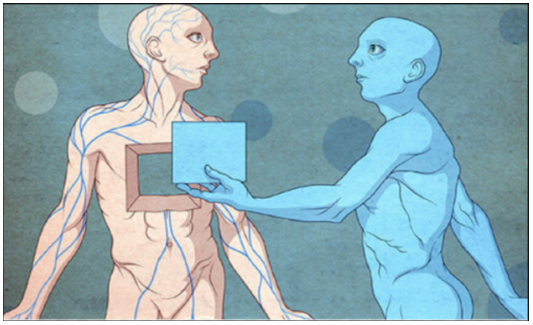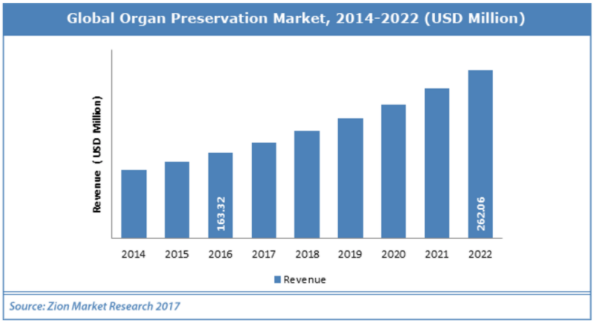This month we are going to take a look at organ preservation, examining the current trends and establishing its importance in transplantation medicine.
Why is organ preservation important? According to United Network of Organ Sharing (UNOS) – an excellent source of information when it comes to transplantation – there are 79 transplant surgeries performed every day in the United States in 2017. Unfortunately however, many patients are not so lucky and, every day approximately 18 people die waiting for a life-saving organ donation. This adds up to 6000 people in the US per year dying due to the shortage of available organs.
In solid organ transplantation the amount of time that an organ can be kept alive outside of the body is very limited. It varies slightly from organ to organ, currently between 6-24 hours. Livers shelf life is between 6-10 hours after removal, heart and lungs are even less, while kidneys can be preserved up to 24 hours.

Credit: organpreservationalliance.com
The short shelf life of organs after removal from the body is a big obstacle when it comes to the surgery itself. The organs have to be removed from the donor, prepared for the surgery and transported to the location where the recipient is. Nonetheless to say, if it had not been done earlier, HLA typing of the donor has to be performed before the operation.
Applying more effective organ preservation techniques would increase the timeframe that an organ can be used for transplantation.
Based on current trends, the organ preservation market is one of the fastest growing areas of transplantation medicine. If the estimates are correct, the total value of the organ preservation market can worth $241,2 M by 2021. Based on the publically available data, this growth rate is around 10% per year, which is very notable.
The organ preservation market is divided to three groups based on the type of the product, the transportation technique and the organ type.
Digging into the scientific literature we observed a peak in the development of new techniques around 2010. In that time a lot of startups began to address the challenge of organ preservation by developing a range of organ preservation products.
The most common preservation solution, the University of Wisconsin cold solution is available under the trademark of ViaSpan, the University of Wisconsin solution. In 2016 ViaSpan was the most widely applied product for the cold storage of organs. ViaSpan was developed in the 1980’s and today holds the largest market share among the organ preservation solutions and is considered the gold-standard among transplant surgeons in the United States.
The organ preservation market is divided to three groups based on the type of the product, the transportation technique and the organ type.
Digging into the scientific literature we observed a peak in the development of new techniques around 2010. In that time a lot of startups began to address the challenge of organ preservation by developing a range of organ preservation products.
The most common preservation solution, the University of Wisconsin cold solution is available under the product of ViaSpan. In 2016 ViaSpan was the most widely applied product for the cold storage of organs. ViaSpan was developed in the 1980’s and today holds the largest market share among the organ preservation solutions and is considered the gold-standard among transplant surgeons in the United States.
Why cooling?
When a solid organ is removed from the body, the removal, storage and transplantation itself alters the homeostasis of the organ. These effects could cause delay for the organ to return to the normal function after the transplantation is completed. The aim of the preservation is to minimize the damage during this time to ensure optimal functioning of the organ after transplantation.
After the organ is removed from the donor, the degenerative reactions are going to continue. These include the accumulation of lactic acid, decrease in intracellular pH, proteolysis, lipolysis and peroxidation. All of the mentioned biodegradable reactions could cause serious damage to the organ leading to higher chance of organ failure after transplantation. One potential and simple solution is cooling down the organs. According to Guibert et al., “Cooling is the first line of defense against hypoxic injury”. When an organ is cooled down, the cellular metabolism is reduced and the oxygen requirement is lower. With cooling ( hypothermia ) it is possible to slow down the speed of these degenerative reactions and extend the time when an organ can be transplanted.
During decades it has been proved that cooling can significantly improve the clinical outcome of the transplantation surgeries.
Cooling or Supercooling?
With the current cold storage, the preservation time is 24h or less based on the organ type. In 2014, a new technique, called supercooling has been developed, tested and shown to be able to increase the lifetime of organs up to 72 hours.
While, the technique has only been tested using rat livers, it is a promising start. Believe it or not, the supercooling has been inspired by nature. The North American wood frog is a fantastic creature, that is able to hibernate in freezing conditions that would normally kill other species. This gace the idea to scientists to look for a possible cooling method that would make it possible to go below zero degree and still maintain the functionality of the organs.

Credit: Wally Reeves, Korkut Uygun, Martin Yarmush – Harvard University
Researchers from Harvard University published their study in Nature about the effects of supercooling organs. The key message of the technique is to cool organs down to -6°C degrees without allowing the development of freezing ice crystals in the preserving solutions. To preserve the organs, a special machine is used to maintain the chemical buffer zone around the organ’s cells. The buffer protects the cell’s membrane against the ice. In the experiments six rats received supercooled livers that had been kept below 0°C for 3 days, and all of the rats survived for 3 days.
After such an impressive start, we are eager to see what other methods will be developed to increase the life of the donated organs.
Sure enough, market forecasts suggest that in the next five years the demand for donated organs and for techniques that could serve transplantation medicine will grow significantly. What may be driving this? Growing the need for life saving transplants and ever improving technologies – let’s see what new technologies can compete!
Written by Fruzsina Félegyházi, Field Application Scientist






